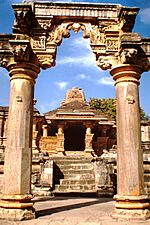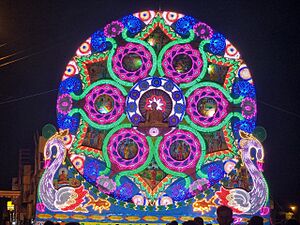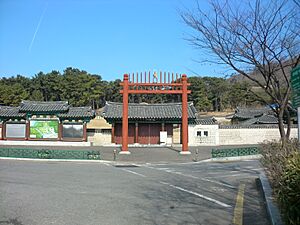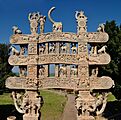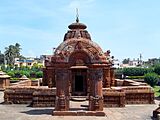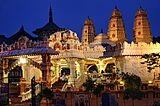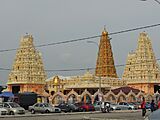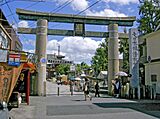Torana facts for kids
A torana is a special kind of gateway or archway. You can find them in Hindu, Buddhist and Jain buildings in places like India. These beautiful gateways are used for important ceremonies.
You can also see toranas in many parts of Southeast Asia and East Asia. For example, the famous torii gates in Japan, Chinese Shanmen gates, and Korean Hongsalmun gates all got their ideas from the Indian torana. Sometimes, toranas are also called vandanamalikas.
Contents
History of Toranas
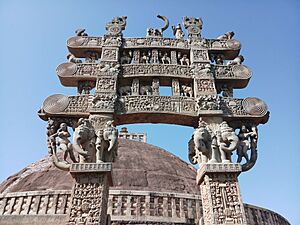
Experts believe that toranas first appeared in ancient India. They might have come from the simple gates of villages during the Vedic period (around 1500 BCE to 500 BCE). Over time, these simple gates became grand and decorative. They were used at the entrances of cities, palaces, and holy places.
Ancient Indian texts, like the Arthasastra, mention that different types of gates should be used to decorate city or palace entrances.
Archaeologists have found old stone pieces that show how early toranas looked. For example, a piece of a stone arch found in Pataliputra, India, might be from a very old torana. It even has ancient writing on it!
The famous toranas at the Sanchi Stupa are very old. They date back to the 3rd century BCE. These stone gates probably looked like even older wooden gates that were popular in India.
Many temples in India have toranas. In the Kalinga region, temples built between the 7th and 12th centuries often feature them. Good examples include the Jagannath Temple, Puri and the Mukteswar Temple.
In Gujarat, many toranas were built by the Chaulukya dynasty between the 10th and 12th centuries. These were usually part of temples.
Different Types of Toranas
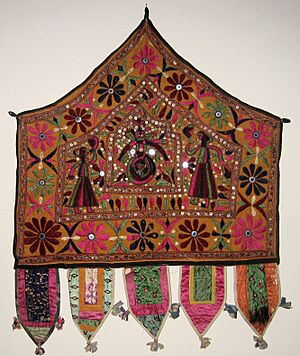
There are many different kinds of toranas, each with its own name and style:
- Patra-torana: These are made to look like leaves, or are decorated with leaf designs.
- Puspa-torana: These are made from beautiful flowers.
- Ratna-torana: These are decorated with precious stones.
- Stambha-torana: These are built on pillars.
- Citra-torana: These are decorated with paintings.
- Bhitti-torana: These are decorations on walls, like over a window or a fake door.
- Dvara-toranas: These are decorations hung over a doorway, or they can be the decorated gateways themselves.
These different types are described in old Indian books about architecture.
Why Toranas are Important
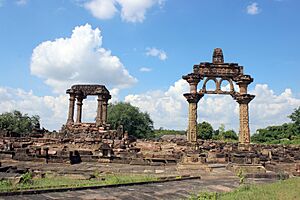
Toranas are more than just pretty gates. They are considered sacred and special in Buddhism and Hinduism. A typical torana has a horizontal beam resting on two upright posts. They are often made of wood or stone. The beam usually has three parts stacked on top of each other. Both the beam and the posts are often beautifully carved with stories or symbols.
You can find toranas at Buddhist stupas, like the Great Stupa in Sanchi. They are also part of Jain and Hindu temples, and even some non-religious buildings.
Sometimes, people make symbolic toranas from flowers or leaves. They hang these over doors and at entrances, especially in Western and Southern India. People believe these bring good luck and show that it's a happy, festive time. Toranas can also tell stories, teach lessons, or celebrate a king's victory.
During the Vesak festival in Sri Lanka, people put up large, colorful toranas that light up with electricity. These are temporary decorations that stay up for a few weeks around the festival.
Thorana (Vesak Festival)
During the Vesak festival in Sri Lanka, it's a tradition to build large, colorful, and electrically lit Thoranas (also called Pandols) in public places. These are often organized by communities or businesses. These amazing decorations are temporary. They stay up for a couple of weeks starting from the day of Vesak. These big structures attract many local people in Sri Lanka, and also visitors from all over the world.
Toranas Around the World
Many places outside India were influenced by Indian culture a long time ago. This happened through trade and the spread of religions like Buddhism. For example, the Japanese goddess Benzaiten is actually based on the Hindu goddess Saraswati. Even an ancient Indian writing style, the Siddhaṃ script, is still used by monks in Japan today, even though it disappeared from India centuries ago.
The ancient Indian torana gateway style has influenced gateway designs across Asia. This is especially true in places where Buddhism traveled from India. Chinese paifang gates, Japanese torii gates, Korean hongsalmun gates, and the Sao Ching Cha in Thailand all got their ideas from the Indian torana. They all serve similar purposes, but their designs look different based on their local architectural styles.
There's even a Torana Gate in Brickfields, Kuala Lumpur, Malaysia. It was a gift from the Government of India to Malaysia. It looks just like the gates at the Sanchi Stupa and was finished in 2015.
Japanese Torii Gates
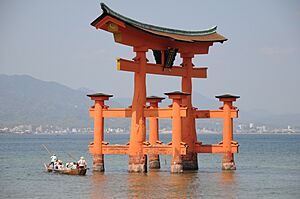
The torii is a famous gateway in Japan. You can find one at the entrance of every Shinto shrine. Many experts believe that the torii gate originally came from the Indian torana. Both the name and the design show how they are connected. A torana is a free-standing, sacred gateway that marks the entrance to a holy place, like a Hindu or Buddhist temple.
Korean Hongsalmun and Iljumun Gates
The hongsalmun is a special gate used to enter sacred places in Korea. It has two tall, round poles standing upright and two horizontal bars. It doesn't have a roof or a door. At the very top, there's often a symbol like the trisula (a three-pronged spear) or the taegeuk (the yin-yang symbol). Hongsalmun gates are usually found at Korean Confucian sites, such as shrines, tombs, and old academies.
The Iljumun is another type of gate found in Korean Buddhist temples. It's known for having a single line of pillars, even if there are multiple columns.
Chinese Paifang Gates
The paifang, also called a pailou, is a traditional Chinese archway or gateway. It first came from the Indian torana when Buddhism was introduced to China. Over time, it developed into many different styles. The paifang then spread to other East Asian countries like Korea, Japan, and Vietnam.
Gallery
Toranas in India
- Hindu, Buddhist and Jain toranas
-
The back of the North Torana at Stupa-1, Sanchi Hill, India. It dates from the 3rd to 1st century BCE.
-
A Hindu Torana from the 12th-century Kakatiya dynasty at Warangal Fort, India.
Toranas Overseas
- Hindu, Buddhist and and Jain toranas outside India
-
The Torana of Sri Sivan Temple in Singapore, built in 1993.
-
The Torana Gate in Brickfields, Kuala Lumpur, Malaysia, built in 2015.
-
A Torana at the front of the Fiji Sanatan Society of Alberta in Edmonton, Canada. It was built in 1984.
Derived Styles
- Related styles
-
A Japanese torii at the entrance of Shitennō-ji, a Buddhist temple in Osaka
See also
- Glossary of Hinduism terms
- Toran, ceremonial Indian door decoration
- Torii, in Japan architecture
- Paifang, in Chinese architecture
- Hongsalmun, in Korean architecture with both religious and other usage
- Iljumun, portal in Korean Buddhist architecture
- Shanmen, in Chinese Buddhist architecture
- Tam quan, in Vietnamese Buddhist architecture
- Trụ biểu, in Vietnamese architecture



